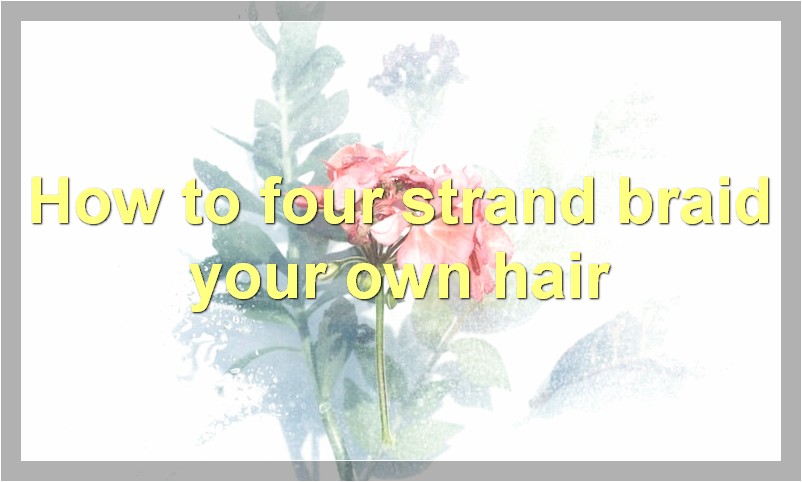If you’re tired of shelling out money for someone to do your hair, or if you’re just looking for a new skill to learn, braiding your own hair is a great option!
How do you braid your own hair
If you’re anything like me, you’re probably always looking for new ways to style your hair. Braids are a great way to add some interest to your look, but they can be tricky to do on yourself. Here’s a step-by-step guide to french braiding your own hair:
Start with clean, dry hair. If your hair is wet, it will be more difficult to work with and the braid won’t hold as well. Section off a small section of hair at the front of your head and divide it into three even strands.
Begin braiding by crossing the right strand over the middle strand. Then, take the left strand and cross it over the new middle strand. Continue this pattern until you reach the end of your hair.
Once you reach the end of your hair, secure the braid with an elastic band. Gently tug on the braid to loosen it up and give it a more relaxed look.
There you have it! A simple guide to french braiding your own hair. With a little practice, you’ll be able to master this technique in no time.
How to French braid your own hair

When it comes to hair, there are many different styles that you can choose from. Braids are a popular choice, as they can be both stylish and practical. French braids are a type of braid that is often seen in magazines and on celebrities. While they may look complicated, French braids are actually quite easy to do once you get the hang of it. In this article, we will show you how to French braid your own hair in just a few simple steps.
Before you begin, make sure that your hair is clean and dry. If your hair is oily or wet, the braid will not hold as well. You will also need to add some product to your hair to help keep it in place. We recommend using a small amount of hairspray or gel.
Now that you are ready to start, divide your hair into three equal sections. Take the right section and cross it over the middle section. Then, take the left section and cross it over the new middle section. Continue crossing the sections until you reach the end of your hair.
Once you reach the end of your hair, secure the braid with an elastic band. To finish off the look, you can wrap a small piece of hair around the elastic band to hide it. And that’s it! You have now successfully completed a French braid.
How to Dutch braid your own hair
When it comes to learning how to Dutch braid your own hair, there are a few things you need to keep in mind. First, make sure your hair is clean and dry before you start. Second, use a comb to section off a small subsection of hair from the front of your head, and then begin braiding this section backwards towards the back of your head. Finally, as you braid, be sure to add more hair to the sections you are working with, so that the braid becomes increasingly tight.
Now that you know the basics of how to Dutch braid your own hair, let’s take a closer look at each step in detail.
As we mentioned before, it’s important that your hair is clean and dry before you start braiding. This will help ensure that your braid lasts longer and doesn’t come undone as easily. To wet or dampen your hair, use a spray bottle filled with water. Then, comb your hair thoroughly to remove any knots or tangles.
Once your hair is prepped and ready to go, it’s time to start sectioning off subsections for braiding. For Dutch braids, you will want to create three even sections of hair. To do this, use a comb to create a part down the middle of your head, from your forehead to the nape of your neck. Then, create another part slightly off to one side. You should now have three sections of hair: one down the middle and two on either side.
Now it’s time to start braiding! Take the section of hair closest to your forehead and divide it into three even subsections. Then, begin braiding these subsections backwards towards the back of your head. As you braid, be sure to add more hair to the sections you are working with. This will help create a tighter braid. Once you reach the back of your head, secure the end of the braid with an elastic band.
Repeat this process with the other two sections of hair until all three sections have been braided. You can then gently tug on each braid to loosen it up a bit and give it a more relaxed look.
And there you have it! Now you know how to Dutch braid your own hair in just a few simple steps.
How to fishtail braid your own hair
When it comes to fishingtail braids, there are two main methods: the classic three-strand braid and the Dutch braid. The classic three-strand braid is the most basic method and is typically what people think of when they hear “fishingtail braid.” To do this type of braid, start by dividing your hair into three even sections. Take the right section and cross it over the middle section, then take the left section and cross it over the new middle section. Continue crossing the sections until you reach the end of your hair, then secure the braid with an elastic. The Dutch braid is a bit more complicated and looks like a French braid on top of your head (hence the name “Dutch” braid). To do this type of braid, start by creating a small hole in your hair near the forehead. Then, divide your hair into three sections like you would for a regular fishtail braid. Take the right section and cross it over the middle section, then take the left section and cross it over the new middle section. However, instead of just crossing the sections over, also add a small piece of hair from each side to the corresponding section as you cross it over. This will cause the braid to “crawl” up your head as you continue braiding. When you reach the end of your hair, secure the braid with an elastic.
How to waterfall braid your own hair
A waterfall braid is a beautiful and elegant hairstyle that can be worn for any occasion. If you’re looking to add a little something extra to your look, try waterfall braiding your own hair! It’s not as difficult as it looks and with practice, you’ll be able to achieve the perfect waterfall braid every time. Here’s how to do it:
Start with clean, dry, and styled hair. Gather a small section of hair from the front of your head and divide it into three even sections. Begin a standard three-strand braid by crossing the rightmost section over the middle section, then the leftmost section over the new middle section. Continue braiding down the length of your hair, adding in small sections of hair as you go. When you reach the end of your hair, secure the braid with an elastic band.
To create the waterfall effect, gently pull apart each loop of the braid to create an opening. Next, take a small section of hair from underneath the braid and bring it over the top of the braid, tucking it into the opening. Repeat this step on each loop of the braid until you reach the end. Secure the end of the braid with another elastic band and mist with hairspray to keep everything in place.
Waterfall braids are a stunning way to style your hair and with a little practice, you can easily do them yourself at home!
How to four strand braid your own hair

Learning how to four strand braid your own hair is not as difficult as it may seem. With a little practice, you’ll be able to do it in no time!
Start by dividing your hair into four sections. You can use a comb or your fingers to do this. Then, take one section of hair and divide it into two smaller sections.
Next, take the outermost section of hair and cross it over the middle section. Then, take the innermost section of hair and cross it over the middle section. Repeat this process until you reach the end of your hair.
Once you’ve reached the end of your hair, secure the braid with an elastic band. And that’s it! You’ve successfully four strand braided your own hair!
How to lace braid your own hair
How to Lace Braid Your Own Hair
Lace braids are a beautiful and elegant way to style your hair, and they’re not as difficult as they may look. With a little practice, you’ll be able to lace braid your own hair in no time. Here’s how:
Start with clean, dry, and styled hair. If your hair is damp, it will be more difficult to work with. Gather a small section of hair from each side of your head, just behind your ears. These sections should be about the same size.
Cross the two sections of hair over the top of your head, and tie them together with a clear elastic band.
Divide the hair into three even sections. Take the right-most section and cross it over the middle section. Then take the left-most section and cross it over the new middle section.
Continue crossing the sections of hair over one another until you reach the ends. Secure the braid with another clear elastic band.
To add some extra flair, you can pull on the sections of hair to make the braid look fuller. You can also wrap a piece of ribbon or string around the base of the braid for a unique touch.
How to reverse braid your own hair
Do you know how to braid your own hair? If not, don’t worry – it’s not as difficult as it looks. In fact, once you get the hang of it, you’ll be able to do it in your sleep!
The first thing you need to do is gather your hair into a ponytail at the top of your head. Then, divide the ponytail into three sections. Take the section closest to your forehead and cross it over the middle section. Then, take the section farthest away from your forehead and cross it over the newly middle section. Repeat this process until you reach the end of your hair.
Once you’ve reached the end, simply tie off the braid with a hair tie. And that’s it! You’ve successfully reversed braided your own hair.
How to cornrow braid your own hair
How to cornrow braid your own hair: a step-by-step guide
If you’re looking for a way to change up your hairstyle, why not try cornrow braiding? It’s a stylish and practical way to keep your hair out of your face, and it’s not as difficult as it looks. With a little practice, you’ll be able to cornrow braid your own hair in no time.
Here’s a step-by-step guide on how to cornrow braid your own hair:
1. Start with clean, dry, and brushed hair. If your hair is oily or curly, you may want to use a light spray of hairspray or gel to help keep the braids in place.
2. Divide your hair into sections. For thicker hair, you may want to divide it into three sections. For thinner hair, two sections may be sufficient. Use clips or ponytail holders to keep the sections separated.
3. Begin braiding each section of hair, starting at the roots. As you braid, add small sections of hair from the sides of the section you’re working on. This will help the braid lie flat against your head.
4. When you reach the end of each section, secure the braid with a clear elastic band or small clip.
5. Repeat steps 2-4 until all of your hair is braided.
6. To give your cornrow braids a polished look, use a boar bristle brush to gently smooth down the edges of each braid. You can also spray them with a light mist of hairspray or water.
7. Let your cornrow braids air dry, or sleep in them overnight for tighter, longer-lasting curls.
How to make a braided bun with your own hair
A braided bun is a classic hairstyle that can be worn for any occasion. Whether you’re headed to a formal event or just want to look put-together for work, a braided bun is a great option. And the best part is, you can do it yourself with just a few simple steps.
Start by brushing your hair to remove any knots or tangles. Then, gather your hair into a low ponytail at the nape of your neck. If you want your bun to be extra full, you can pull some hair out from the ponytail to create a “teased” effect.
Next, divide your ponytail into three equal sections. Begin braiding each section, using whatever braid style you prefer (French, Dutch, fishtail, etc.). Once you’ve reached the end of each braid, secure it with an elastic band.
Now it’s time to start creating your bun. Take the first braid and wrap it around the base of the ponytail, securing it with bobby pins as you go. Repeat with the remaining two braids until all of your hair is pulled back and secured. Finish off by spraying your bun with hairspray to keep everything in place.
And there you have it! A perfect braided bun that you can rock all day long.





